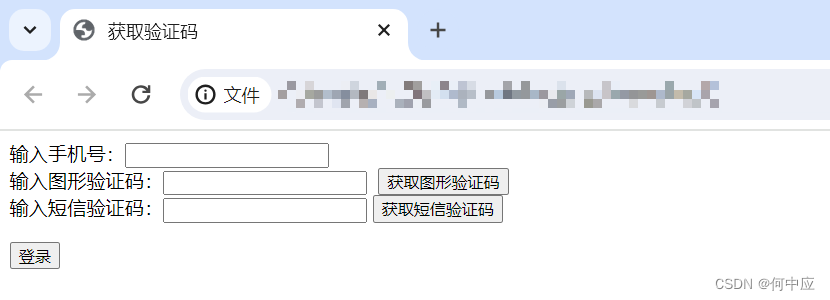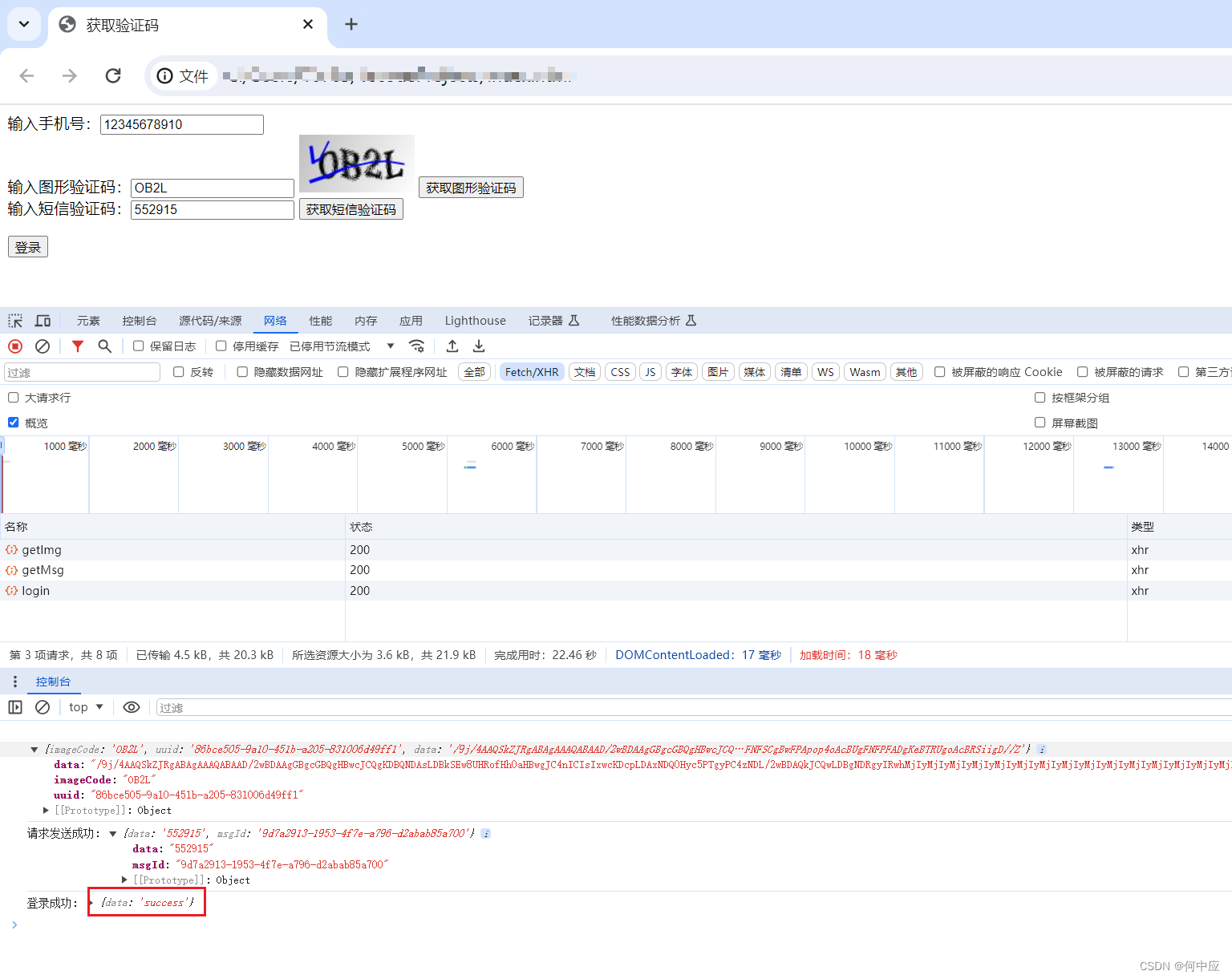移动端双验证码登录实现
说明:本文介绍如何用图形验证码+短信验证码实现移动端登录思路;
分析
通过手机号+图形验证码+手机验证码实现登录的时序图如下:

说明:
-
(1)用户进入登录界面,出现图形验证码,可点击图形验证码更换图片;
-
(2)后端返回图形验证码的base64地址,加上一个uuid,该uuid为验证码在Redis中存储的Key;
-
(3)用户输入手机号、uuid、图形验证码,获取手机短信验证码;
-
(4)后端根据uuid去Redis中获取图形验证码,与用户输入的进行比较,通过发送短信验证码,同时将短信验证码的MessageId与验证码存入Redis中,不通过返回错误信息;
-
(5)用户输入手机号、uuid、messageId、图形验证码、手机验证码登录;
-
(6)后端根据uuid、messageId去Redis中获取验证码,分别与用户输入的验证码比较,通过登录成功,发Token,不通过返回错误信息;
前端实现
首先,做一个简单的页面,如下:

页面有三个接口,分别是:获取图形验证码,获取短信验证码,登录,代码如下:
<!DOCTYPE html>
<html lang="en">
<head>
<meta charset="UTF-8">
<meta http-equiv="X-UA-Compatible" content="IE=edge">
<meta name="viewport" content="width=device-width, initial-scale=1.0">
<title>获取验证码</title>
<script src="js/axios-0.18.0.js"></script>
</head>
<body>
输入手机号:<input type="text" id="phone">
<br>
输入图形验证码:<input type="text" id="img">
<img id="pic" />
<input type="button" value="获取图形验证码" onclick="getImg()">
<br>
输入短信验证码:<input type="text" id="msg">
<input type="button" value="获取短信验证码" onclick="getMsg()">
<br>
<p></p>
<input type="button" value="登录" onclick="login()">
</body>
<script>
// 图形验证码返回的uuid
let uuid = "";
// 短信验证码返回的msgId
let msgId = "";
function getImg() {
// 异步交互ajax
axios.get("http://localhost:8080/getImg")
.then(response => {
// 接收响应回来的数据
console.log(response.data);
uuid = response.data.uuid;
document.getElementById("pic").src = 'data:image/jpeg;base64,' + response.data.data;
})
}
function getMsg() {
// 手机号
const phone = document.getElementById("phone").value;
// 图形验证码
const imgValue = document.getElementById("img").value;
const data = {
phone:phone,
imgValue: imgValue,
uuid: uuid
};
// 发送 POST 请求
axios.post("http://localhost:8080/getMsg", data)
.then(response => {
console.log("请求发送成功:", response.data);
msgId = response.data.msgId
})
.catch(error => {
console.error("请求发送失败:", error);
});
}
function login() {
// 手机号
const phone = document.getElementById("phone").value;
// 图形验证码
const imgValue = document.getElementById("img").value;
// 短信验证码
const msgValue = document.getElementById("msg").value;
// 构造登录请求的数据对象
const loginData = {
phone: phone,
imgValue: imgValue,
msgValue: msgValue,
uuid: uuid,
msgId: msgId
};
// 发送 POST 请求
axios.post("http://localhost:8080/login", loginData)
.then(response => {
console.log("登录成功:", response.data);
})
.catch(error => {
console.error("登录失败:", error);
});
}
</script>
</html>
图像验证码使用使用Kaptcha实现,参考:
后端实现
KaptchConfig类
import com.google.code.kaptcha.impl.DefaultKaptcha;
import com.google.code.kaptcha.util.Config;
import org.springframework.context.annotation.Bean;
import org.springframework.stereotype.Component;
import java.util.Properties;
@Component
public class KaptchConfig {
@Bean
public DefaultKaptcha getDefaultKaptcha() {
// 创建验证码工具
com.google.code.kaptcha.impl.DefaultKaptcha defaultKaptcha = new com.google.code.kaptcha.impl.DefaultKaptcha();
// 验证码配置
Properties properties = new Properties();
// 图片边框
properties.setProperty("kaptcha.border", "no");
// 边框颜色
properties.setProperty("kaptcha.border.color", "black");
//边框厚度
properties.setProperty("kaptcha.border.thickness", "1");
// 图片宽
properties.setProperty("kaptcha.image.width", "120");
// 图片高
properties.setProperty("kaptcha.image.height", "60");
//图片实现类
properties.setProperty("kaptcha.producer.impl", "com.google.code.kaptcha.impl.DefaultKaptcha");
//文本实现类
properties.setProperty("kaptcha.textproducer.impl", "com.google.code.kaptcha.text.impl.DefaultTextCreator");
//文本集合,验证码值从此集合中获取
properties.setProperty("kaptcha.textproducer.char.string", "0123456789ABCDEFGHIJKLMNOPQRSTUVWXYZ");
//验证码长度
properties.setProperty("kaptcha.textproducer.char.length", "4");
//字体
properties.setProperty("kaptcha.textproducer.font.names", "宋体");
//字体颜色
properties.setProperty("kaptcha.textproducer.font.color", "black");
//文字间隔
properties.setProperty("kaptcha.textproducer.char.space", "4");
//干扰实现类
properties.setProperty("kaptcha.noise.impl", "com.google.code.kaptcha.impl.DefaultNoise");
//干扰颜色
properties.setProperty("kaptcha.noise.color", "blue");
//干扰图片样式
properties.setProperty("kaptcha.obscurificator.impl", "com.google.code.kaptcha.impl.WaterRipple");
//背景实现类
properties.setProperty("kaptcha.background.impl", "com.google.code.kaptcha.impl.DefaultBackground");
//背景颜色渐变,结束颜色
properties.setProperty("kaptcha.background.clear.to", "white");
//文字渲染器
properties.setProperty("kaptcha.word.impl", "com.google.code.kaptcha.text.impl.DefaultWordRenderer");
// 创建验证码配置实例
Config config = new Config(properties);
// 验证码工具
defaultKaptcha.setConfig(config);
return defaultKaptcha;
}
}
三个接口实现;
import com.google.code.kaptcha.impl.DefaultKaptcha;
import org.springframework.beans.factory.annotation.Autowired;
import org.springframework.data.redis.core.StringRedisTemplate;
import org.springframework.web.bind.annotation.*;
import javax.annotation.Resource;
import javax.imageio.ImageIO;
import java.awt.image.BufferedImage;
import java.io.ByteArrayOutputStream;
import java.io.IOException;
import java.util.Base64;
import java.util.Map;
import java.util.concurrent.TimeUnit;
@RestController
@CrossOrigin
public class KaptchController {
@Resource
DefaultKaptcha defaultKaptcha;
@Autowired
private StringRedisTemplate redisTemplate;
/**
* 生成图形验证码
*/
@GetMapping("/getImg")
public Map getImg() throws IOException {
// 生成文字验证码
String imageCode = defaultKaptcha.createText();
// 生成图片验证码
ByteArrayOutputStream out = new ByteArrayOutputStream();
BufferedImage image = defaultKaptcha.createImage(imageCode);
ImageIO.write(image, "jpg", out);
// 生成uuid,将uuid作为key,验证码作为value存入redis
String uuid = java.util.UUID.randomUUID().toString();
redisTemplate.opsForValue().set(uuid, imageCode, 60, TimeUnit.SECONDS);
// 对字节组Base64编码
return Map.of("data", Base64.getEncoder().encodeToString(out.toByteArray()), "uuid", uuid, "imageCode", imageCode);
}
/**
* 生成短信验证码
*/
@PostMapping("/getMsg")
public Map getCode(@RequestBody Map<String, String> map) throws IOException {
// 获取相关参数
String phone = map.get("phone");
String uuid = map.get("uuid");
String imgValue = map.get("imgValue");
// 根据uuid获取图形验证码
String imageCode = redisTemplate.opsForValue().get(uuid);
// 校验手机号是否合法
if (phone == null || phone.length() != 11) {
return Map.of("data", "手机号不合法");
}
// 图形验证码是否过期
if (imageCode == null) {
return Map.of("data", "验证码已过期");
}
// 是否输入正确
if (!imageCode.toUpperCase().equals(imgValue.toUpperCase())) {
return Map.of("data", "验证码错误");
}
// 生成6位数的短信验证码
String msgCode = String.valueOf((int) ((Math.random() * 9 + 1) * 100000));
// 生成msgId,将msgId作为key,验证码作为value存入redis
String msgId = java.util.UUID.randomUUID().toString();
redisTemplate.opsForValue().set(msgId, msgCode, 60, TimeUnit.SECONDS);
return Map.of("data", msgCode, "msgId", msgId);
}
/**
* 登录
*/
@PostMapping("/login")
public Map login(@RequestBody Map<String, String> map) {
// 获取相关参数
String phone = map.get("phone");
String uuid = map.get("uuid");
String imgValue = map.get("imgValue");
String msgId = map.get("msgId");
String msgValue = map.get("msgValue");
// 根据uuid、msgId获取图形验证码、短信验证码
String imageCode = redisTemplate.opsForValue().get(uuid);
String msgCode = redisTemplate.opsForValue().get(msgId);
// 校验手机号是否合法
if (phone == null || phone.length() != 11) {
return Map.of("data", "手机号不合法");
}
// 图形验证码是否过期
if (imageCode == null) {
return Map.of("data", "验证码已过期");
}
// 是否输入正确
if (!imageCode.toUpperCase().equals(imgValue.toUpperCase())) {
return Map.of("data", "验证码错误");
}
// 短信验证码是否过期
if (msgCode == null) {
return Map.of("data", "验证码已过期");
}
// 是否输入正确
if (!msgCode.equals(msgValue)) {
return Map.of("data", "验证码错误");
}
// 登录成功,删除Redis中的验证码
redisTemplate.delete(uuid);
redisTemplate.delete(msgId);
return Map.of("data", "success");
}
}
测试
测试正常情况

测试图形验证码输入错误的情况

测试短信验证码输入错误的情况(图中“登录成功”为接口访问成功的信息,并非通过了登录校验)

基本实现了,正式情况还需要考虑更严格的手机号校验,手机验证码防频繁点击,手机短信登录第三方API接入,规范验证码在Redis中Key的格式,验证码在Redis中的过期时间等等,这里仅是一个Demo,但上述实现思路是值得考虑的。
总结
本文介绍了移动端双验证码登录的实现,希望能对大家有所启发。
原文地址:https://blog.csdn.net/qq_42108331/article/details/137890702
免责声明:本站文章内容转载自网络资源,如本站内容侵犯了原著者的合法权益,可联系本站删除。更多内容请关注自学内容网(zxcms.com)!
